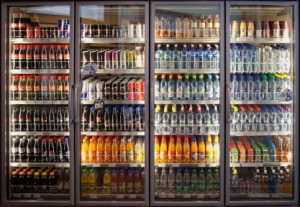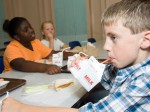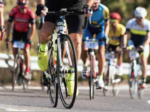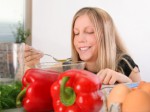 In 2015 New Zealanders consumed a total of 518 million liters of carbonated drinks. Many of these were consumed by children.
In 2015 New Zealanders consumed a total of 518 million liters of carbonated drinks. Many of these were consumed by children.
In the 2002 National Children’s Nutrition Survey it was found that on a weekly basis children drank a variety of fluids.
NZ children’s weekly drinks consumption
| Drink | % consumption |
|---|---|
| Soft drink | 45 |
| Cola drinks | 43 |
| Mountain dew | 9 |
| Powdered fruit | 54 |
| Cordial/concentrate | 32 |
| Sports drink | 8 |
| New Age | 6 |
| Tea | 21 |
| Coffee | 6 |
| Juice | 43 |
| Milk | 34 |
Outside of the drinking of milk and water there is real concern about the energy content of some of these beverages because of our rising incidence of diabetes and obesity.
In New Zealand 35% of our children are overweight or obese. As obesity is a major risk factor for Type 2 diabetes experts warn that New Zealanders are facing a ‘diabetes tsunami’ if more is not done to help people to control their weight and improve their diet. Drinks that are high in sugar are also of concern to dental health.
What is all the fuss about?
- With the exception of unflavoured milk the sugar (carbohydrate) and energy content of many of these drinks is high which not only can have an obeseogenic effect but can also be harmful to tooth enamel.
- Many of these drinks contain additives such as preservatives, colourings and flavouring agents that may affect the behavior of susceptible individuals. Along with caffeine many ‘new age’ drinks now also add vitamins, taurine, ginseng and guarana for added appeal. While these additions may be‘trendy’, they can not supplement or make up for an unhealthy diet
- They can be expensive
- Some of these drinks also contribute significant amounts of sodium that can reduce bone density.
Products aimed at young people are carrying mischievous names such as Illicit venom, Illicit rebel, Mother, Demon and Monster. For added effect some drinks also carry warnings and claims such as: “double hit”, “No limits”, “Fuels man genius”, “No Laws”, “vitalizes body and mind”. While young people do like to rebel they are still very self-conscious about their body, hair, skin and nails all factors that could be aided by drinking milk and water instead.
A comparison of common drinks
| Serve | Serving size | Carbo per serve |
Carbo per 100ml |
Protein per 100ml |
Kj/kcal per 100ml |
Sodium per 100ml |
Calcium per 100ml |
Caffeine per 100ml |
Additives |
|---|---|---|---|---|---|---|---|---|---|
| Water | 0 | 0 | 0 | 0 | 8.0mg | 2.3mg | 0 | ||
| Powerade® | 750ml | 57 | 7.6 | 0 | 133/32 | 28 | 0 | 0 | Acidity regulators (330, 331), Colour 133, flavours, tri-potassium citrate, sodium chloride, tri-potassium phosphate. |
| Mizone® | 750ml | 29 | 3.9 | ≤1 | 69/17 | 23 | 0 | 0 | Flavours, salt, Vit C, B3, B5, B6, B12, Colour 129 |
| Loaded® | 1000ml | 75 | 7.5 | 0 | 131/31 | 43.4 | 0 | 0 | Acidity regulators (330, 331), flavour, preservative 202, sodium chloride, tri-potassium citrate, potassium chloride, colour 133 |
| Ice Tea | 500ml | 34 | 6.8 | 0 | 115/28 | ≤5 | 0 | 0 | Tea extract, Acids 296, 330, 331, antioxidant 300 |
| Coca cola® | 250ml | 27 | 10.6 | 0 | 180/43 | 10 | 0 | YES | 150d, 338 |
| Fanta® | 250ml | 31 | 12.3 | 0 | 212/50 | 5 | 0 | 0 | Acids (330, 331), antioxidant 300, preservative 202 |
| Lemonade | 250ml | 25 | 9.9 | 0 | 172/41 | 14 | 0 | 0 | Acids (330, 331, 211) |
| Gingerbeer | 250ml | 28 | 11.3 | 0 | 197/47 | 8.4 | 0 | 0 | Similar to above |
| Orange juice | 250ml | 24 | 9.6 | ≤1 | 178/43 | 1 | Vitamin A, C | ||
| Trim® milk | 200ml | 9.8 | 4.9 | 3.7 | 160/38 | 45 | 130mg | 0 | calcium |
| Calci-trim® | 200ml | 9.6 | 4.8 | 5.7 | 185/44 | 45 | 200mg | 0 | calcium, vitamin D |
| Light blue® | 200ml | 9.6 | 4.8 | 3.5 | 200 | 45 | 125mg | 0 | |
| A2® | |||||||||
| Primo® | 200ml | 18.8 | 9.4 | 3.3 | 180/67 | 40 | 115mg | 0 | Thickeners 407, Vitamin A, D |
| Calci yum® | 250ml | 20.5 | 8.2 | 3.4 | 252/60 | 42 | 193mg | 0 | Vegetable gums (400, 466, 470), calcium carbonate, flavours, Vitamin D |
| Iced coffee | 200ml | 16.4 | 8.2 | 3.5 | 270/65 | 40 | 115mg | YES | Caffeine, thickener 407, flavours |
| Yoghurt drinks | 250ml | 30.2 | 12.1 | 3 | 275/66 | 31 | 100mg | 0 | Thickeners (1440, 1442), Pectin, Halal gelatine, acidity regulator (330), lemon juice, Preservative 200, culture. |
| Up n Go® | 250ml | 27.5 | 11 | 3.5 | 320/77 | 60 | 160mg | 0 | Acidity regulators (332), Vegetable gums (460, 466, 470), vitamins |
| Mother® | 500ml | 52 | 10.4 | 0 | 195/47 | 52 | 0 | 32mg | Food acids 330, 331, taurine, glucuronolactone, colours (150d, 104), preservative 202, caffeine, flavour, inositol, vitamins (nicacin, pantothenic acids, B6, B12), guarana extract |
| Lift Plus® | 500ml | 51 | 11.7 | 0 | 210/50 | 19 | 0 | 14.5mg | Food acids (330, 331), flavour, colour (150d), preservative 202, caffeine, guarana extract, antioxidant 300, gingseng extracts, vitamins (niacin, thiamine) |
| V® | 500ml | 53 | 10.6 | ≤1 | 195/47 | 115 | 0 | 31mg | Taurine, guarana extract, colour (caramel), glucuronolactone, preservatives (sodium benzoate, potassium sorbate), caffeine, inositol, vitamins (niacin B3, pantothenic acid, B6, riboflavin B2) |
| Demon® | 568ml | 68 | 12 | ≤1 | 218/52 | 51 | 0 | 32mg | Food acids (330, 331), flavours, taurine, preservative 202, colour 150c, caffeine, guarana extract, vitamins (niacinamide, pantothenic acid). |
| Red Bull® | 250ml | 27 | 11 | 0 | 192/46 | 40 | 0 | 32mg | Taurine, caffeine, glucuronolactone, inositol, vitamins (niacinamide, pantothenic acid), B6, B12, flavours, colours (caramel , riboflavin) |
Caffeine and Guarana
- Caffeine is a substance that occurs naturally in the leaves, nuts and seeds of a number of plants.
- Guarana is a climbing plant, native to Brazil that acts as a stimulant and provides approximately twice as much caffeine as found in coffee beans.
- Major dietary sources of caffeine, such as tea, coffee, chocolate and cola drinks typically provide 30-100 mg of caffeine per serve, while some non-prescriptive medications contain 100 -200 mg of caffeine per tablet.
- The recent introduction of caffeine (or guarana) to ‘energy drinks’, confectionery and sports foods/supplements has increased.
- Any benefit to the addition of caffeine to drinks is likely to involve the reduced perception of effort or fatigue as well as direct effects of muscle.
- At higher levels of intake, caffeine has the potential to cause increases in heart rate, impairments or alterations of fine motor control and technique, and over-arousal (interfering with recovery and sleep patterns). Impairment of technique may affect the performance of a number of sports, and over-arousal may interfere with the ability to recover between training sessions, or multi-day competitions. These concerns add to the importance of finding the lowest effective dose of caffeine that can be used to achieve a performance enhancement.
- Although evidence of specific health problems is equivocal, long-term intake of large amounts of caffeine (>500 mg per day for adults) are generally discouraged by health authorities and there are no safe levels of caffeine for children.
Taurine
- Taurine is an amino sulphonic acid, promoted as having a detoxifying effect opening the muscles to improve sugar uptake. In reality humans are able to synthesize Taurine from protein rich foods in the diet such as meat and sea foods.
Gingseng
- A root found in America and Asia that has a mildly stimulating effect.
B group vitamins
These vitamins assist energy metabolism in the body but widely occur in foods.
- Vitamin B1 Thiamin and B6 are found in whole grains
- Vitamin B2 Riboflavin and B12 is found in eggs and dairy products
- Pantothenic acid is widely distributed in most unprocessed foods.
- Vitamin B3 Niacin is found in meat, coffee,fish and whole grains.
How do these drinks compare on price?
The range of cheap drinks available is growing and now that Coke Cola is available in 2L bottles it is proving cheaper than even milk bought in bulk..
| Drink Type | Range Cost per 100ml | Examples |
|---|---|---|
| Coke cola | 0.19 | 2L |
| Water | 0.28-0.87 | Flavoured water, coconut, vitamin added |
| Sports drinks | 0.43 | Powerade |
| Iced tea | 0.51 | Liptons |
| Energy drinks | 0.45-0.79 | Mother, Lift plus, V, Monster, Demon, Illicit |
| Soft drinks | 0.56-0.73 | Fanta, lemonade, coke, ginger beer |
| Juice | 0.87 | Pure orange |
| Milk drinks | ||
| Bulk milk | 0.18-0.24 | Calci-trim, trim, light blue, A2 |
| Flavoured milk | 0.47-0.84 | Primo, calci yum, iced coffee |
| Yoghurt drinks | 0.66-1.59 | Drinking yoghurt, The Collective yoghurt |
| Soy milk | 0.74 | Up & Go |
Competition in the beverage market
Competition in the beverage market place is fierce.
Schools
Regulations regarding the sale of healthy foods and beverages in school canteens (NAG. 5 s3) were removed by the government in 2009 concerned that such regulations on food choice were adopting a “nanny state” approach. This was to the dismay of health professionals as research supports the view that children learn more about healthy eating when their environment e.g. tuck shops, school camps and fund-raising activities, also supports healthy food choices. Studies of schools in Western Australia that have adopted healthy food and drink policies were pleasantly surprised to find an increase in canteens reporting break-even and both parents and children generally accepted the need to make dietary changes in an effort to reduce obesity and improve child health (Pettigrew 2012).
Luckily the NZ Heart Foundations Healthy Heart Award is still available for schools here who want guidelines on providing healthier food choice in their canteens(http://heartfoundation.org.nz).
Incentives
In schools, sporting venues and club rooms soft drink companies not only provide free refrigerators for their products but also help these organisations with their fund-raising by offer sponsorship to sports teams for equipment and team uniforms. Fonterra’s recent decision to trial the provision of free milk and refrigerators in some schools is an initiative welcomed by many within the community who are wanting healthy beverages readily available for our children.
Placement
Recent research (Smith 2010) has found that much of the food and beverages being marketed to young children in the unregulated environment of sporting venues is energy dense and nutrient poor. Not only do 80% of NZ children play sport but within this environment there is also the opportunity to provide a range of marketing strategies e.g. sponsorship, celebrity endorsements, free giveaways, fundraising incentives etc. to promote “junk foods” to children
What can parents do?
- Keep soft drinks for special family occasions rather than serving them on a weekly or daily basis.
- If children are overweight always provide a lower energy (diet) option and seek professional help.
- Sports drinks are only useful as an electrolyte replacement in situations where sweat losses occur. As most children don’t sweat before puberty then these drinks can be limited to use by adolescents, leaving younger children to drink milk or water.
- Encourage children to drink more milk by offering them a milk shake or smoothie after school. For recipes visit our milkshake ideas. If you are concerned about your childs consumption of these drinks or are wanting to assess the impact of soft drink on your child’s daily energy and nutrient intake then contact us for a nutritional assessment.























































Leave a Reply